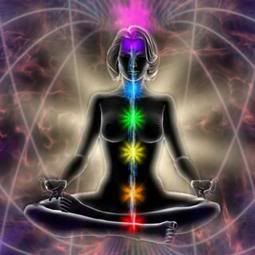Post by bluefedish on May 21, 2007 17:51:39 GMT -5
The Study of Chakras. There are 7 Basic Chakras.
The 1st Chakra called Sahasrara or the Crown Chakra. This represents the consciousness, the master chakra that controls all the others. It's symbolised by a lotus with a thousand petals. It's located above the head outside the body.
The 2nd Chakra is called Ajna or 3rd Eye. This is linked to the pineal gland, the chakra of time and awareness and of light. The pineal gland is a light sensitive gland that produces the hormone melatonin, which regulates the instincts of going to sleep and awakening. It's symbolised by a lotus with 2 pettals.
The 3rd Chakra is called Vishuddha or Throat Chakra. This is related to communication and growth, growth being a form of expression. This is paralleled to the thyroid, a gland that is also in the throat and produces thyroid hormone, responsible for growth and maturation. This is symbolised by a lotus with 16 petals.
The 4th Chakra is called Anahata or Heart Chakra. This represents the higher emotion, compassion, love, equilibrium, and well-being. It's related to the thymus, located in the chest. This organ is part of the immune system and part of the endocrine system. It produces T cells responsible for fighting off disease and affected by stress. This is sybolised by a lotus with 12 petals.
The 5th Chakra is called Manipura/Nabhi or Solar Plexus Chakra. This represents transistion from base to higher emotion, energy, assimilation and digestion, and corresponds with the pancreas and the outer adrenal glands & the adrenal cortex. These play a valuable role in digestion, the conversion of food matter into energy for the body. This is symbolised by a lotus with 10 petals.
The 6th Chakra is called Swadhisthana or Sacral Chakra. This is located in the groin, related to the base emotion, sexuality and creativity. Corresponds with the testicles or overies that produce various sex hormones involved in the reproductive cycle, which can cause dramatic mood swings. This is symbolised by a lotus with 6 petals.
The 7th Chakra is called Muladhara or Base or Root Chakra. This represents instinct, security, survival and to basic human potentiality. This is located in the genitals and the anus & is related to the inner adrenal glands, the adrenal medulla, responsible for the fight and flight response when survival is under threat. In this region is located a muscle that controls ejaculation in the sexual act. A parallel is drawn between the spern cell and the ovum, where the genetic code lies coiled, and the Kundalini. This is symbolised by a lotus with 4 petals.

The 1st Chakra called Sahasrara or the Crown Chakra. This represents the consciousness, the master chakra that controls all the others. It's symbolised by a lotus with a thousand petals. It's located above the head outside the body.
The 2nd Chakra is called Ajna or 3rd Eye. This is linked to the pineal gland, the chakra of time and awareness and of light. The pineal gland is a light sensitive gland that produces the hormone melatonin, which regulates the instincts of going to sleep and awakening. It's symbolised by a lotus with 2 pettals.
The 3rd Chakra is called Vishuddha or Throat Chakra. This is related to communication and growth, growth being a form of expression. This is paralleled to the thyroid, a gland that is also in the throat and produces thyroid hormone, responsible for growth and maturation. This is symbolised by a lotus with 16 petals.
The 4th Chakra is called Anahata or Heart Chakra. This represents the higher emotion, compassion, love, equilibrium, and well-being. It's related to the thymus, located in the chest. This organ is part of the immune system and part of the endocrine system. It produces T cells responsible for fighting off disease and affected by stress. This is sybolised by a lotus with 12 petals.
The 5th Chakra is called Manipura/Nabhi or Solar Plexus Chakra. This represents transistion from base to higher emotion, energy, assimilation and digestion, and corresponds with the pancreas and the outer adrenal glands & the adrenal cortex. These play a valuable role in digestion, the conversion of food matter into energy for the body. This is symbolised by a lotus with 10 petals.
The 6th Chakra is called Swadhisthana or Sacral Chakra. This is located in the groin, related to the base emotion, sexuality and creativity. Corresponds with the testicles or overies that produce various sex hormones involved in the reproductive cycle, which can cause dramatic mood swings. This is symbolised by a lotus with 6 petals.
The 7th Chakra is called Muladhara or Base or Root Chakra. This represents instinct, security, survival and to basic human potentiality. This is located in the genitals and the anus & is related to the inner adrenal glands, the adrenal medulla, responsible for the fight and flight response when survival is under threat. In this region is located a muscle that controls ejaculation in the sexual act. A parallel is drawn between the spern cell and the ovum, where the genetic code lies coiled, and the Kundalini. This is symbolised by a lotus with 4 petals.




